23 May Fun with Fiddle and Guitar! Interview with Suzy & Eric Thompson
[vc_row css_animation="" row_type="row" use_row_as_full_screen_section="no" type="full_width"...

[vc_row css_animation="" row_type="row" use_row_as_full_screen_section="no" type="full_width"...
[vc_row css_animation="" row_type="row" use_row_as_full_screen_section="no" type="full_width"...
...
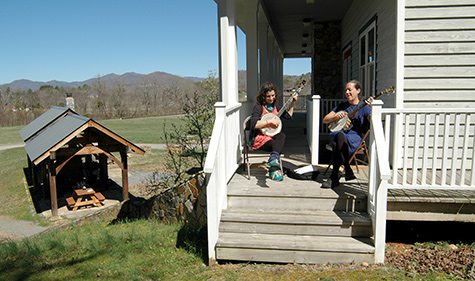 Leah and Aubrey Atwater play "Red Rocking Chair" on the Music Studio Porch.[/caption]
Leah and Aubrey Atwater play "Red Rocking Chair" on the Music Studio Porch.[/caption]
CP: Welcome back to the Folk School. What’s it like to be back as a second-time host?
LD: It has been so incredible to be back in this community. It’s a bit like coming back to folk-craft-musical-dance wonderland. Some of the cast of characters has changed, but the heart of the matter is the same.
[caption id="attachment_10266" align="alignright" width="215"]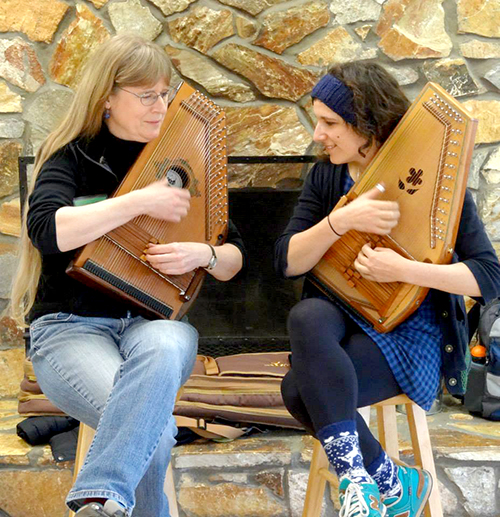 Karen Mueller and Leah Dolgoy[/caption]
Karen Mueller and Leah Dolgoy[/caption]
CP: How is the Folk School different than your regular life?
LD: I think the best way to illustrate this is by telling you about what I’ve been up to between my last host term and my return to the Folk School. I finished my last host term in August 2011 and went back to school that September. Conventional school. Graduate school in Occupational Therapy. I remember the first day I went to get my ID card. I went to a computer and used a touch screen to print out a number. And then proceeded to wait in line for hours while cranky people all around me played on their iPhones. I remember thinking to myself, “when you register at the Folk School, a work study greets you, hands you a map, tells you how to find your housing through the woods, and directs you to the room with the freshly baked cookies.” Having just finished conventional school, it is so nice to return to a Danish Folk School model of learning.
I arrived at the Folk School for my current host term on Christmas Day. I walked into Keith House, and was just struck by the comforting familiarity of everything around me. The smell of the wood, the creaky floors, the feeling of the Jr. host room at the top of the stairs. Then Winter Dance Week started. Suddenly I was in a literal embrace with all of these dear lovely folks I hadn’t seen in two years. I would run into friends in the contra dance line. I very quickly became re-acclimatized to the rhythm of how things are around here – morning song, ringing the bell, the exact time it takes to walk from any point on campus to the dining hall and not be late.
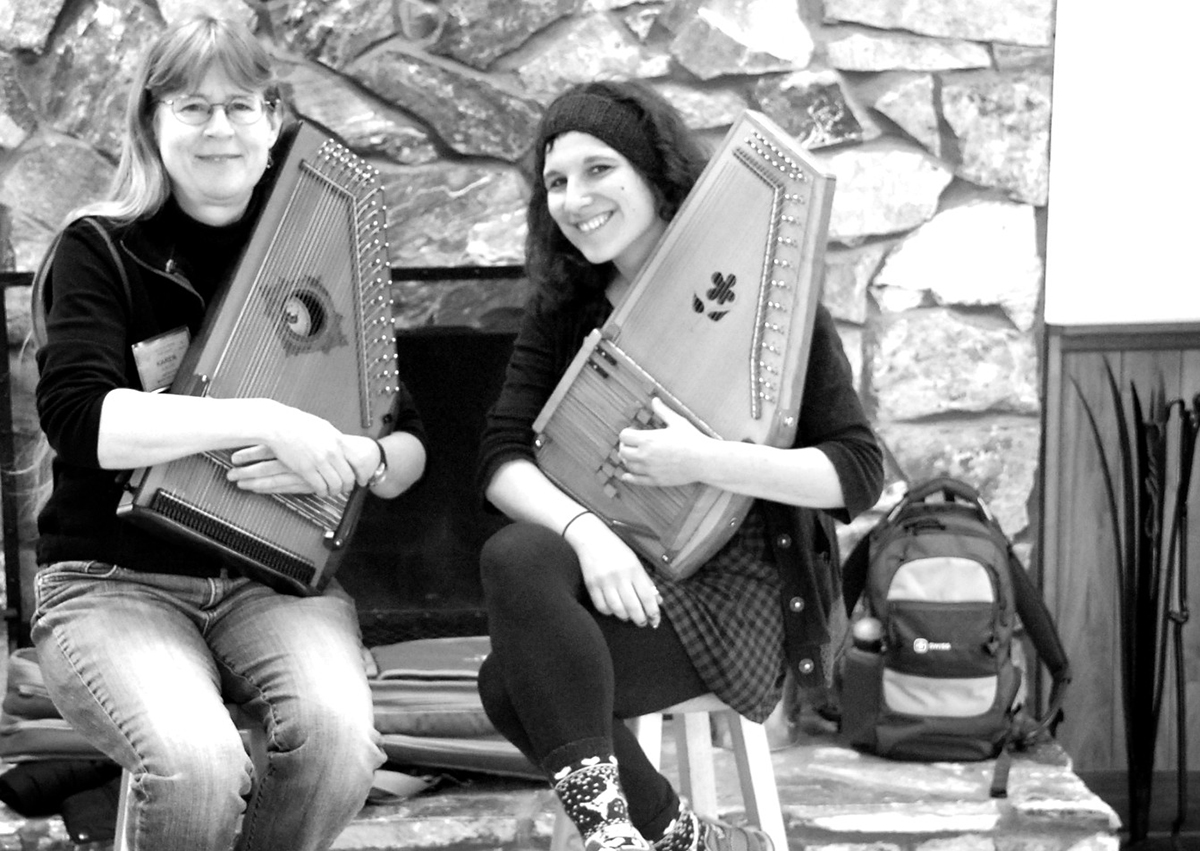 Karen Mueller & Leah Dolgoy in front of the hearth in the Music Studio, Davidson Hall[/caption]
LD: How did you get started playing the autoharp and the dulcimer?
KM: I have played both instruments since high school. I started because there was a bluegrass festival that I discovered in my hometown of Winfield, Kansas. I wasn’t raised with bluegrass music. I knew folk, rock, pop, and classical music, but the more I was around bluegrass and old time, the more I liked it. I saw people playing these instruments really well, doing things I didn’t know you could, which piqued my curiosity. My dad and I built my first dulcimer and I taught myself to play both instruments from recordings and just by watching people whenever I could. [Karen also plays guitar, mandolin and ukulele.]
[caption id="attachment_9814" align="alignright" width="228"]
Karen Mueller & Leah Dolgoy in front of the hearth in the Music Studio, Davidson Hall[/caption]
LD: How did you get started playing the autoharp and the dulcimer?
KM: I have played both instruments since high school. I started because there was a bluegrass festival that I discovered in my hometown of Winfield, Kansas. I wasn’t raised with bluegrass music. I knew folk, rock, pop, and classical music, but the more I was around bluegrass and old time, the more I liked it. I saw people playing these instruments really well, doing things I didn’t know you could, which piqued my curiosity. My dad and I built my first dulcimer and I taught myself to play both instruments from recordings and just by watching people whenever I could. [Karen also plays guitar, mandolin and ukulele.]
[caption id="attachment_9814" align="alignright" width="228"]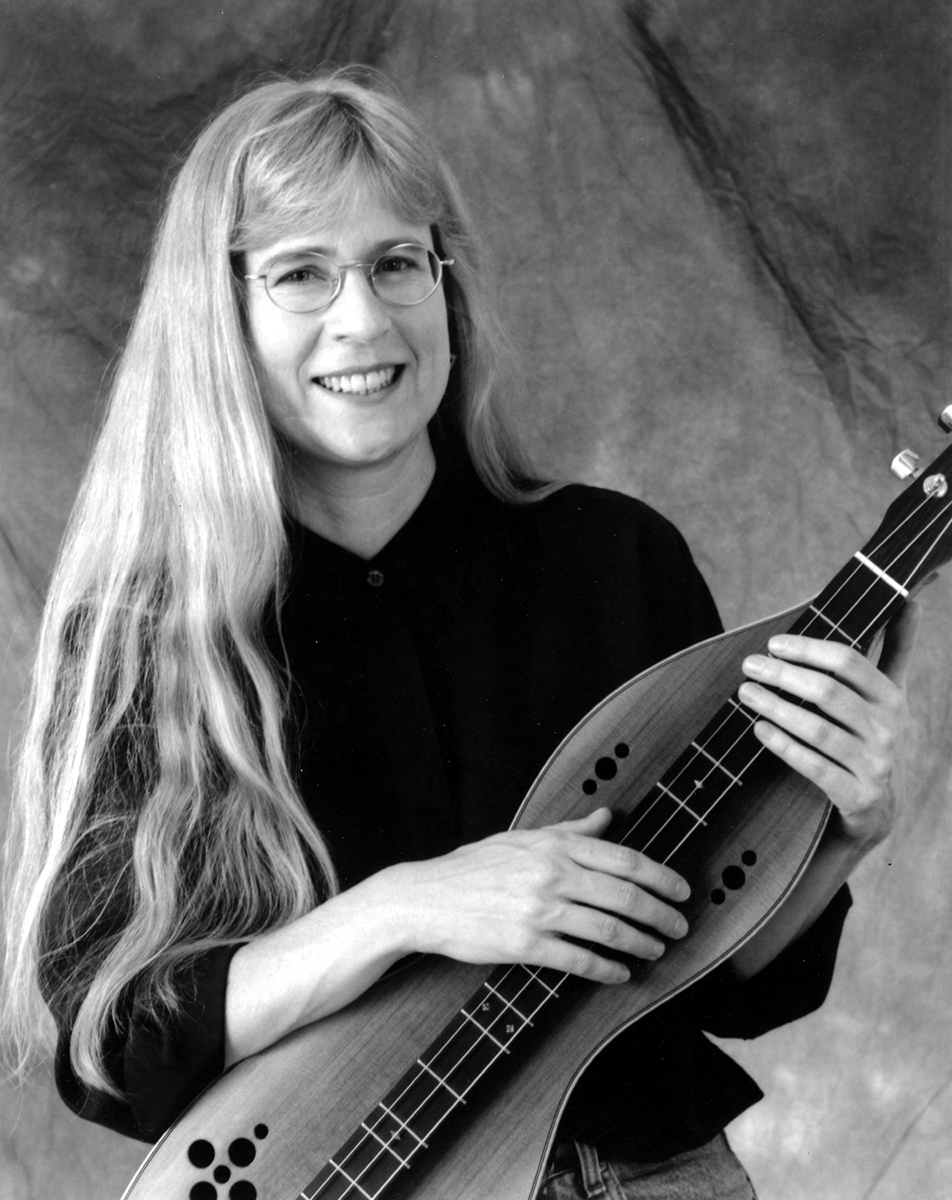 Karen and her dulcimer[/caption]
LD: When you were a kid, what did you want to be when you grew up?
(laughs) I had no idea! I was really into art. I was thinking about visual arts, but I did well academically too. I didn’t see myself being a professional musician. I loved music more than anything, but I didn’t want to pursue the classical arena. I had really intense classical piano studies until I was about 15 and then I was ready to take a break. I picked up the classical guitar just as intensely. Once I picked up the strings, I really felt more in touch with that than with the piano.
To pursue music at college would have required I go to the conservatory and take the classical route and I was just done with that. I didn’t see a career as a folk musician being a viable option. That career just had to gradually develop over time. When I was in college at the University of Kansas I tried to meet other musicians in the community even though I was studying all the time. I met some people that I played with regularly and we formed a band. When I graduated, I thought I would take that proverbial year off and decide whether to pursue grad school and in what discipline (I was in Art History and English, with a minor in Fine Arts and had done journalism too).
So I took a year off and got a job with a jewelry maker doing really high-end gold and silver smithing and still played pretty seriously with my band from college. I also got a Celtic band going. Both bands rehearsed twice a week, and gigged on the weekends, so I learned the craft of being in a working band: the playing as well as the administrative end of it. Meanwhile I still had the security of a full time job. I was earning more with the band than I was with the full time job so I just kept going with that.
When I moved to Minneapolis, I hooked up with a music school and music store to give lessons and still did temping and office work while I was building up my student base. I started touring more as a solo artist, was quickly playing in 4 bands, and then gradually I realized that I had enough students that I didn’t have to do the other stuff. I had no illusions that it was going to be easy or that it was going to happen because I said it was going to happen. It really was a day-by-day thing. I get a lot of calls now inviting me to events, so I don’t have to do the same kind of outreach anymore. And your network of contacts keeps spreading so you get more ideas of where and how to set up things over time.
LD: If you could collaborate with a musician living or dead, who would it be?
I’ve covered songs by Sting, and now he is playing the lute too. That would be a trip!
I would add Maybelle Carter, Eliza Gilkyson, and the Swedish band Väsen to that list too.
Karen and her dulcimer[/caption]
LD: When you were a kid, what did you want to be when you grew up?
(laughs) I had no idea! I was really into art. I was thinking about visual arts, but I did well academically too. I didn’t see myself being a professional musician. I loved music more than anything, but I didn’t want to pursue the classical arena. I had really intense classical piano studies until I was about 15 and then I was ready to take a break. I picked up the classical guitar just as intensely. Once I picked up the strings, I really felt more in touch with that than with the piano.
To pursue music at college would have required I go to the conservatory and take the classical route and I was just done with that. I didn’t see a career as a folk musician being a viable option. That career just had to gradually develop over time. When I was in college at the University of Kansas I tried to meet other musicians in the community even though I was studying all the time. I met some people that I played with regularly and we formed a band. When I graduated, I thought I would take that proverbial year off and decide whether to pursue grad school and in what discipline (I was in Art History and English, with a minor in Fine Arts and had done journalism too).
So I took a year off and got a job with a jewelry maker doing really high-end gold and silver smithing and still played pretty seriously with my band from college. I also got a Celtic band going. Both bands rehearsed twice a week, and gigged on the weekends, so I learned the craft of being in a working band: the playing as well as the administrative end of it. Meanwhile I still had the security of a full time job. I was earning more with the band than I was with the full time job so I just kept going with that.
When I moved to Minneapolis, I hooked up with a music school and music store to give lessons and still did temping and office work while I was building up my student base. I started touring more as a solo artist, was quickly playing in 4 bands, and then gradually I realized that I had enough students that I didn’t have to do the other stuff. I had no illusions that it was going to be easy or that it was going to happen because I said it was going to happen. It really was a day-by-day thing. I get a lot of calls now inviting me to events, so I don’t have to do the same kind of outreach anymore. And your network of contacts keeps spreading so you get more ideas of where and how to set up things over time.
LD: If you could collaborate with a musician living or dead, who would it be?
I’ve covered songs by Sting, and now he is playing the lute too. That would be a trip!
I would add Maybelle Carter, Eliza Gilkyson, and the Swedish band Väsen to that list too.
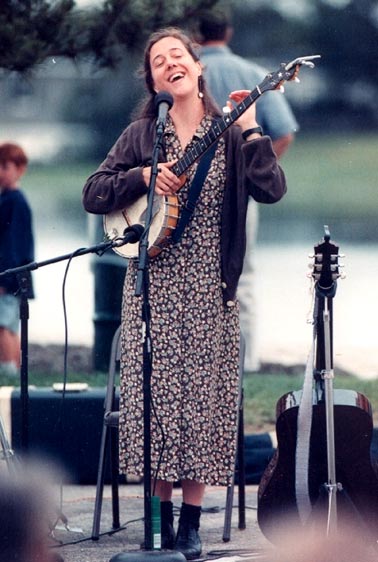 Using clogging, music and storytelling to charm Folk School audiences since 1996, Aubrey exudes a talent, grace, and humor unique to only the most tenured and talented of performers. Aubrey returns to the Folk School this September to teach two dynamite classes: Singing with Clawhammer Banjo (Sept. 8-13) and Clogging (Sept. 13-15 - Weekend). She is also scheduled to perform in special Thursday night concert, Sept. 12, 7 p.m. Don't miss out on this opportunity to learn to play, laugh, sing, and dance with Aubrey this fall!
I recently checked in with Aubrey to talk to her about her upcoming classes, the Folk School, tunes, heroes, dance moves, folk music, the Phoebe, and more! Here's what we talked about:
CP: You teach quite regularly at the Folk School. How did you find the Folk School? When did you teach your first class?
AA: I got the idea to apply to the folk school in the mid-90s when I saw that one of my dulcimer player mentors, Lorraine Hammond, from Boston, was working there. I got in touch, sent materials, and was invited to teach my first class in 1996. I thought I had died and gone to heaven-what a unique, beautiful, nurturing, and exciting place! Teaching a 30+ hour dulcimer class felt daunting back then for my younger self. I was nearly quivering on the plane as I travelled to the Folk School. I have learned a lot over the years teaching at the Folk School. The luxury of time in the week-long class has been a great opportunity to refine and expand my teaching.
CP: Do you think anyone can learn to sing? Do you have to know how sing well to take your classes?
AA: YES to first question - I think anyone can learn to sing. Absolutely NO to second question - you do not need to know how to sing well to take my classes. This question reminds me of college when I took a few drawing classes at the Rhode Island School of Design. I realized that maybe I didn't have a deeply inherent gift, but I learned the skill quite well. Some people can easily SING and it is beautiful, like when they are three years old. Some people don't have the gift quite as well, but I have never ever denied someone who wanted to sing or learn to control the pitch of their voice better. I think of two students in particular over the years who considered themselves "tone deaf" and we worked together, trained, and over time, I heard each of them sing on pitch. There were tears. It was quite a moment, very moving!
[caption id="attachment_8338" align="alignleft" width="234"]
Using clogging, music and storytelling to charm Folk School audiences since 1996, Aubrey exudes a talent, grace, and humor unique to only the most tenured and talented of performers. Aubrey returns to the Folk School this September to teach two dynamite classes: Singing with Clawhammer Banjo (Sept. 8-13) and Clogging (Sept. 13-15 - Weekend). She is also scheduled to perform in special Thursday night concert, Sept. 12, 7 p.m. Don't miss out on this opportunity to learn to play, laugh, sing, and dance with Aubrey this fall!
I recently checked in with Aubrey to talk to her about her upcoming classes, the Folk School, tunes, heroes, dance moves, folk music, the Phoebe, and more! Here's what we talked about:
CP: You teach quite regularly at the Folk School. How did you find the Folk School? When did you teach your first class?
AA: I got the idea to apply to the folk school in the mid-90s when I saw that one of my dulcimer player mentors, Lorraine Hammond, from Boston, was working there. I got in touch, sent materials, and was invited to teach my first class in 1996. I thought I had died and gone to heaven-what a unique, beautiful, nurturing, and exciting place! Teaching a 30+ hour dulcimer class felt daunting back then for my younger self. I was nearly quivering on the plane as I travelled to the Folk School. I have learned a lot over the years teaching at the Folk School. The luxury of time in the week-long class has been a great opportunity to refine and expand my teaching.
CP: Do you think anyone can learn to sing? Do you have to know how sing well to take your classes?
AA: YES to first question - I think anyone can learn to sing. Absolutely NO to second question - you do not need to know how to sing well to take my classes. This question reminds me of college when I took a few drawing classes at the Rhode Island School of Design. I realized that maybe I didn't have a deeply inherent gift, but I learned the skill quite well. Some people can easily SING and it is beautiful, like when they are three years old. Some people don't have the gift quite as well, but I have never ever denied someone who wanted to sing or learn to control the pitch of their voice better. I think of two students in particular over the years who considered themselves "tone deaf" and we worked together, trained, and over time, I heard each of them sing on pitch. There were tears. It was quite a moment, very moving!
[caption id="attachment_8338" align="alignleft" width="234"]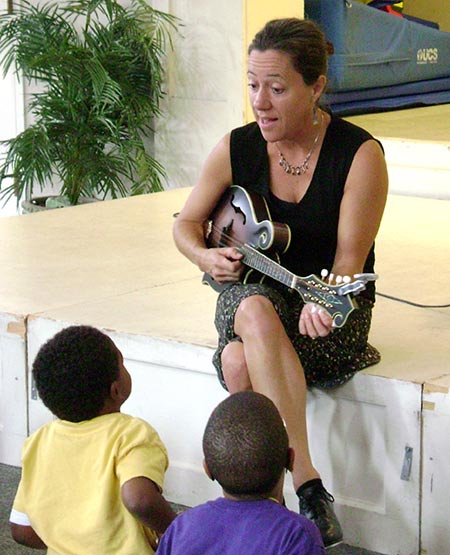 Aubrey charms audiences of all ages![/caption]
CP: What came first for you, playing music or dancing? How did you learn clawhammer banjo? How did you learn to clog?
AA: I started playing piano by ear at about 5 years old, then my parents started me on piano lessons. I quit at 13 and then picked up the guitar at age 15. I had a defining moment that summer in 1979. I figured out how to play two simple chords to a Beatles song and then I sang along and voila! I could play a song and then I was off and running and have never looked back. It was a major turning point in my life.
From there I learned to play the tin whistle, mountain dulcimer and in my late 20's, I went to Eastern Kentucky and started to learn clawhammer banjo and to dance. My friend Cari Norris taught me. She is the granddaughter of the legendary Lily May Ledford, leader of the first all-female string band, The Coon Creek Girls, in the early radio days, so I got to learn from a wonderful lineage of women. When I wasn't with Cari in Kentucky, I'd commission her to send instructional recordings (cassettes!), and she walked me through tunes by ear that way. That same time frame, I learned a few clogging steps (aka Flatfooting) and then over time, I learned traditional freestyle clogging by imitating and collecting steps from percussive dancers I would meet on the road. It was a wondrous and quite traditional way to learn. More than ten years later, somewhere in my 40's, I said to my husband Elwood, with some surprise, "I'm a dancer!" I had never taken dance as a child.
CP: Do you have a favorite tune right now?
AA: Yes, always. It is often whatever song I am learning at the moment. I am always having some kind of a love affair with a song. Two right now are: "The Jamestown Homeward Bound," a 19th century seafaring song and "Mornin's Come, Mariah's Gone," a Jean Ritchie song. Another song I have sung to myself all year is the beautiful hymn "Resignation" written in 1719 by Isaac Watts.
Pete Seeger is famous for saying a song can change the world and I believe that songs help heal our broken hearts. My father died last year and we lost a bunch of other old friends and family members nearly all at once. That one quiet and beautiful song has rescued me over and over again in the last year.
CP: As a musician who has performed multiple times at the Folk School, do you have a tune you always include in your set? How many times have you performed at the Folk School?
AA: I have performed at the Folk School about every year since 1996. It is one of my absolute utter favorite places in the world to play, teach and visit. When I am on that stage and looking at that roomful of smiling, warm, and, now, many familiar faces, I am in one of my happiest places. I often, but not always, play "The Devil and the Farmer's Wife" at the end of my shows. It's a silly, centuries-old song about the devil who comes up from Hell to talk to a dimwitted farmer about taking one of his family members back with him. The farmer says, "Don't take my son, I need him on the farm. But you can have my wife." Then we see how things turn out for the DEVIL. It's a very funny song, still, to this day! Someone captured in on video last time I was there:
Aubrey charms audiences of all ages![/caption]
CP: What came first for you, playing music or dancing? How did you learn clawhammer banjo? How did you learn to clog?
AA: I started playing piano by ear at about 5 years old, then my parents started me on piano lessons. I quit at 13 and then picked up the guitar at age 15. I had a defining moment that summer in 1979. I figured out how to play two simple chords to a Beatles song and then I sang along and voila! I could play a song and then I was off and running and have never looked back. It was a major turning point in my life.
From there I learned to play the tin whistle, mountain dulcimer and in my late 20's, I went to Eastern Kentucky and started to learn clawhammer banjo and to dance. My friend Cari Norris taught me. She is the granddaughter of the legendary Lily May Ledford, leader of the first all-female string band, The Coon Creek Girls, in the early radio days, so I got to learn from a wonderful lineage of women. When I wasn't with Cari in Kentucky, I'd commission her to send instructional recordings (cassettes!), and she walked me through tunes by ear that way. That same time frame, I learned a few clogging steps (aka Flatfooting) and then over time, I learned traditional freestyle clogging by imitating and collecting steps from percussive dancers I would meet on the road. It was a wondrous and quite traditional way to learn. More than ten years later, somewhere in my 40's, I said to my husband Elwood, with some surprise, "I'm a dancer!" I had never taken dance as a child.
CP: Do you have a favorite tune right now?
AA: Yes, always. It is often whatever song I am learning at the moment. I am always having some kind of a love affair with a song. Two right now are: "The Jamestown Homeward Bound," a 19th century seafaring song and "Mornin's Come, Mariah's Gone," a Jean Ritchie song. Another song I have sung to myself all year is the beautiful hymn "Resignation" written in 1719 by Isaac Watts.
Pete Seeger is famous for saying a song can change the world and I believe that songs help heal our broken hearts. My father died last year and we lost a bunch of other old friends and family members nearly all at once. That one quiet and beautiful song has rescued me over and over again in the last year.
CP: As a musician who has performed multiple times at the Folk School, do you have a tune you always include in your set? How many times have you performed at the Folk School?
AA: I have performed at the Folk School about every year since 1996. It is one of my absolute utter favorite places in the world to play, teach and visit. When I am on that stage and looking at that roomful of smiling, warm, and, now, many familiar faces, I am in one of my happiest places. I often, but not always, play "The Devil and the Farmer's Wife" at the end of my shows. It's a silly, centuries-old song about the devil who comes up from Hell to talk to a dimwitted farmer about taking one of his family members back with him. The farmer says, "Don't take my son, I need him on the farm. But you can have my wife." Then we see how things turn out for the DEVIL. It's a very funny song, still, to this day! Someone captured in on video last time I was there:


